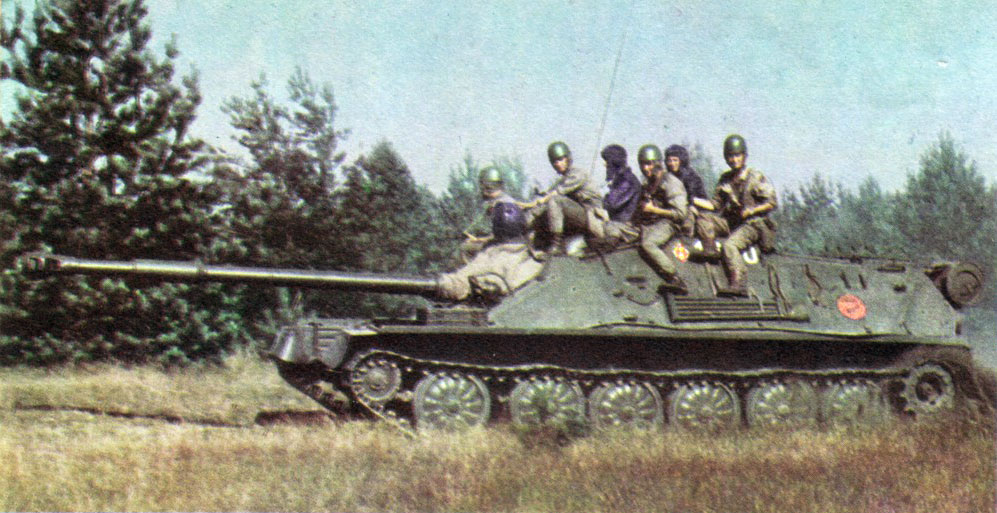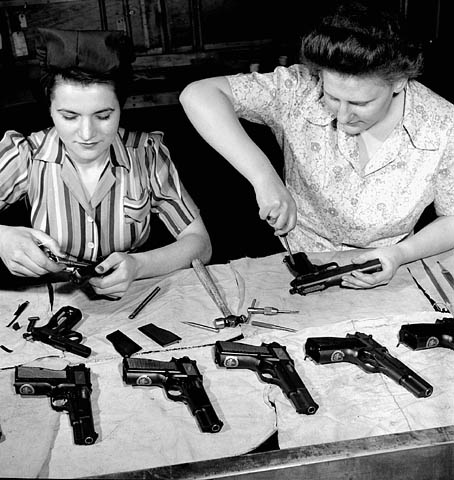|
Mytishchi Machine-Building Plant
OJSC Mytishchi Machine-Building Plant (russian: Мытищинский машиностроительный завод) is a Russian manufacturer of dump trucks and armored tracked vehicles. The plant was formerly part of Metrowagonmash, from which it was spun off in 2009. As of 2016, it is managed by Kalashnikov Concern. OSJC Mytishchi Machine-Building Plant has produced air defense vehicles for the military and has a design bureau for development of these weapons. It also makes products for the civilian automotive industry. The factory was a major supplier of anti-aircraft materiel for the Soviet Union in World War II. Products * ASU-57 * ASU-85 * GM chassis * ZSU-23-4 * ZSU-37 ZSU-37 was a Soviet-made, light, self-propelled anti-aircraft gun (SPAAG), developed by the end of 1943 and produced at Works No. 40 in Mytishchi. It was the first Soviet series-produced tracked SPAAG. ZSU stands for Zenitnaya Samokhodnaya Usta ... References External links Official website {{A ... [...More Info...] [...Related Items...] OR: [Wikipedia] [Google] [Baidu] |
ASU-57
The ASU-57 was a small, lightly constructed Soviet assault gun specifically designed for use by Soviet airborne divisions. From 1960 onwards, it was gradually phased out in favour of the ASU-85. Development history The task to develop a lightweight assault gun for the airborne troops (with either a 57 mm gun or a 76 mm gun) was given to two design bureaus, Astrov (OKB-40) in Mytishchi and Kravtsev in Moscow. Nikolaj Astrov's OKB-40 designed the ASU-76, based on components of the T-70 light tank and the SU-76 assault gun, and armed with the new 76 mm gun D-56T. The ASU-76 turned out to be too heavy, even though the armour was only 3 mm thick, and the project was cancelled. Anatoly Kravtsev's team came up with the similar, amphibious K-73. This vehicle was armed with Charnko's 57 mm anti-tank gun Ch-51 and was even more thinly armoured than the ASU-76. This project too was shelved. In 1949, Astrov was instructed to continue with his project, but with redu ... [...More Info...] [...Related Items...] OR: [Wikipedia] [Google] [Baidu] |
Companies Based In Moscow Oblast
A company, abbreviated as co., is a legal entity representing an association of people, whether natural, legal or a mixture of both, with a specific objective. Company members share a common purpose and unite to achieve specific, declared goals. Companies take various forms, such as: * voluntary associations, which may include nonprofit organizations * business entities, whose aim is generating profit * financial entities and banks * programs or educational institutions A company can be created as a legal person so that the company itself has limited liability as members perform or fail to discharge their duty according to the publicly declared incorporation, or published policy. When a company closes, it may need to be liquidated to avoid further legal obligations. Companies may associate and collectively register themselves as new companies; the resulting entities are often known as corporate groups. Meanings and definitions A company can be defined as an "artificial per ... [...More Info...] [...Related Items...] OR: [Wikipedia] [Google] [Baidu] |
Defence Companies Of Russia
Defense or defence may refer to: Tactical, martial, and political acts or groups * Defense (military), forces primarily intended for warfare * Civil defense, the organizing of civilians to deal with emergencies or enemy attacks * Defense industry, industry which manufactures and sells weapons and military technology * Self-defense, the use of force to defend oneself * Haganah (Hebrew for "The Defence"), a paramilitary organization in British Palestine * National security, security of a nation state, its citizens, economy, and institutions, as a duty of government ** Defence diplomacy, pursuit of foreign policy objectives through the peaceful employment of defence resources ** Ministry of defence or department of defense, a part of government which regulates the armed forces ** Defence minister, a cabinet position in charge of a ministry of defense * International security, measures taken by states and international organizations to ensure mutual survival and safety Sports * Defe ... [...More Info...] [...Related Items...] OR: [Wikipedia] [Google] [Baidu] |
Vehicle Manufacturing Companies Established In 2009
A vehicle (from la, vehiculum) is a machine that transports people or cargo. Vehicles include wagons, bicycles, motor vehicles (motorcycles, cars, trucks, buses, mobility scooters for disabled people), railed vehicles (trains, trams), watercraft (ships, boats, underwater vehicles), amphibious vehicles (screw-propelled vehicles, hovercraft), aircraft (airplanes, helicopters, aerostats) and spacecraft.Halsey, William D. (Editorial Director): ''MacMillan Contemporary Dictionary'', page 1106. MacMillan Publishing, 1979. Land vehicles are classified broadly by what is used to apply steering and drive forces against the ground: wheeled, tracked, railed or skied. ISO 3833-1977 is the standard, also internationally used in legislation, for road vehicles types, terms and definitions. History * The oldest boats found by archaeological excavation are logboats, with the oldest logboat found, the Pesse canoe found in a bog in the Netherlands, being carbon dated to 8040 - 7510 ... [...More Info...] [...Related Items...] OR: [Wikipedia] [Google] [Baidu] |
ZSU-37
ZSU-37 was a Soviet-made, light, self-propelled anti-aircraft gun (SPAAG), developed by the end of 1943 and produced at Works No. 40 in Mytishchi. It was the first Soviet series-produced tracked SPAAG. ZSU stands for Zenitnaya Samokhodnaya Ustanovka (russian: Зенитная Самоходная Установка), meaning "anti-aircraft self-propelled mount". History Soviet engineers carried out some early experiments with tracked SPAAGs before and during World War II, including a modification of the T-70 light tank, resulting in the experimental T-90 SPAAG which was armed with two 12.7 mm DShKT heavy machine guns (the prototype was built in November 1942 by GAZ). The T-70 light tank would eventually be further developed into the SU-76 light self-propelled gun chassis, which in turn was to become the base for the ZSU-37 SPAAG using M1939 anti-aircraft gun. It was decided to use the chassis of the SU-76M in order to speed up and cheapen the production of the much needed ... [...More Info...] [...Related Items...] OR: [Wikipedia] [Google] [Baidu] |
ZSU-23-4
The ZSU-23-4 "Shilka" is a lightly armored Soviet self-propelled, radar-guided anti-aircraft weapon system (SPAAG). Etymology The acronym "ZSU" stands for ''Zenitnaya Samokhodnaya Ustanovka'' (russian: Зенитная Самоходная Установка), meaning "anti-aircraft self-propelled system"; the "23" signifies the bore diameter in millimeters; the "4" signifies the number of gun barrels. It is named after the Shilka River in Russia. Afghan soldiers nicknamed it the "sewing machine" due to the sound of firing guns. It is also referred to by its nickname of "Zeus", derived from the Russian acronym. History The previous Soviet self-propelled anti-aircraft gun (SPAAG), the ZSU-57-2, was armed with two 57 mm autocannons; it was aimed optically using a basic tracking and lead calculating system. The ZSU-57-2 was not particularly successful despite its very powerful autocannons; given their large caliber, it could only carry 300 rounds, was inaccurate as it lacked r ... [...More Info...] [...Related Items...] OR: [Wikipedia] [Google] [Baidu] |
GM Chassis
GM (Russian: ''Gusenichnaya Mashina'', ''Гусеничная машина'', lit. ''tracked machine'') is a series of tracked vehicle chassis. Generally, the series is produced by ''Mytishchi Machine-Building Plant''. Some older series were developed and produced by Minsk Tractor Works (MTZ) GM-569 GM-569 is used for the TELAR 9A38, part of the Buk-M1-2 SAM system. Specifications * Chassis weight: 24,000 kg * Max load: 11,500 kg * Wheelbase: 4,605 mm * Ground clearance: 450 mm * Fuel distance: 500 km * Working environment ** outside temperature: −50°C — +50°C ** relative air humidity: 98% (t = +35 °C) ** overall dust level while driving < 2,5 g/m3 * Max velocity: 65 km/h * Average ground unit pressure < 0,8 kg/cm2 * Engine type: Multifuel liquid-cooled diesel * On-board powerplant: 522 kW (710 h.p.) — 618 kW (840 h.p.) Other types of chassis Designed and developed at |
ASU-85
The ASU-85 (russian: Авиадесантная самоходная установка, АСУ-85, Aviadesantnaya Samokhodnaya Ustanovka, ASU-85 – airborne self-propelled mount) is a Soviet-designed airborne self-propelled gun of the Cold War era. From 1959, it began to replace the open-topped ASU-57 in service. It was, in turn, replaced by the BMD-1 beginning in 1969. Development history Development of a new assault gun for the armed forces started at the OKB-40 design bureau of the Mytishchi Machine Building Plant (MMZ), under the supervision of chief designer Nikolaj Aleksandrovich Astrov. The first Ob'yekt 573 prototype was ready for factory tests in the second half of 1953. This first vehicle was followed by a small batch of three improved vehicles that were evaluated by the armed forces in 1956–1957. The improved vehicles were powered by a new, horizontal six cylinder diesel engine, the YaMZ-206V, instead of the original V-6 of the PT-76. In 1958, the order to start se ... [...More Info...] [...Related Items...] OR: [Wikipedia] [Google] [Baidu] |
World War II
World War II or the Second World War, often abbreviated as WWII or WW2, was a world war that lasted from 1939 to 1945. It involved the vast majority of the world's countries—including all of the great powers—forming two opposing military alliances: the Allies and the Axis powers. World War II was a total war that directly involved more than 100 million personnel from more than 30 countries. The major participants in the war threw their entire economic, industrial, and scientific capabilities behind the war effort, blurring the distinction between civilian and military resources. Aircraft played a major role in the conflict, enabling the strategic bombing of population centres and deploying the only two nuclear weapons ever used in war. World War II was by far the deadliest conflict in human history; it resulted in 70 to 85 million fatalities, mostly among civilians. Tens of millions died due to genocides (including the Holocaust), starvation, ma ... [...More Info...] [...Related Items...] OR: [Wikipedia] [Google] [Baidu] |
Defense Industry
The arms industry, also known as the arms trade, is a global industry which manufactures and sells weapons and military technology. It consists of a commercial industry involved in the research and development, engineering, production, and servicing of military material, equipment, and facilities. Arms-producing companies, also referred to as arms dealers, or as the military industry, produce arms for the armed forces of states and for civilians. Departments of government also operate in the arms industry, buying and selling weapons, munitions and other military items. An arsenal is a place where arms and ammunition - whether privately or publicly owned - are made, maintained and repaired, stored, or issued, in any combination. Products of the arms industry include guns, artillery, ammunition, missiles, military aircraft, military vehicles, ships, electronic systems, military communications, night-vision devices, holographic weapon sights, laser rangefinders, laser sights, ... [...More Info...] [...Related Items...] OR: [Wikipedia] [Google] [Baidu] |
Soviet Union
The Soviet Union,. officially the Union of Soviet Socialist Republics. (USSR),. was a transcontinental country that spanned much of Eurasia from 1922 to 1991. A flagship communist state, it was nominally a federal union of fifteen national republics; in practice, both its government and its economy were highly centralized until its final years. It was a one-party state governed by the Communist Party of the Soviet Union, with the city of Moscow serving as its capital as well as that of its largest and most populous republic: the Russian SFSR. Other major cities included Leningrad (Russian SFSR), Kiev (Ukrainian SSR), Minsk ( Byelorussian SSR), Tashkent (Uzbek SSR), Alma-Ata (Kazakh SSR), and Novosibirsk (Russian SFSR). It was the largest country in the world, covering over and spanning eleven time zones. The country's roots lay in the October Revolution of 1917, when the Bolsheviks, under the leadership of Vladimir Lenin, overthrew the Russian Provisional Government ... [...More Info...] [...Related Items...] OR: [Wikipedia] [Google] [Baidu] |






